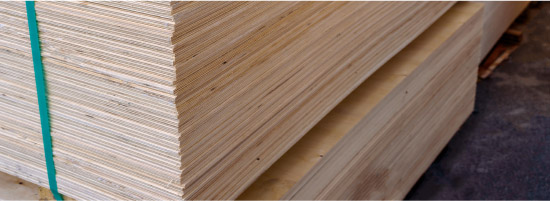- Home
- Resources
- Amerhart Insider Blog
- Construction & Design Trends
- Best Practices for Storing Hardwood Plywood
Best Practices for Storing Hardwood Plywood

A common concern with hardwood plywood is maintaining the quality of the veneer face during handling and storing. Checking along the grain of hardwood plywood face veneers can occur because of fluctuations in conditions like temperature and humidity, but there are steps you can take to protect your investment.
Here are three articles that Amerhart VP of Sales & Marketing David Destiche recommends if you want to deepen your understanding of best practices for storing hardwood plywood.
Tight Side Out or Loose Side Out?
By S. Leavengood, J. W. Funck and J. E. Reeb
Published in the International Wood Products Journal
This article may challenge your thinking on how to store hardwood plywood. It reports on a study exploring whether checking is greater on the loose side of the veneer and can be reduced with finishing techniques.
The authors found that, “Contrary to conventional wisdom, panels oriented with the tight side of the face veneer oriented out checked significantly more than panels with the loose side oriented out.” They also observed that the application of a clear film-forming finish did not have any effect on checking.
Ten Best Practices to Reduce Checking
By Robert Gilmore and Stephen J. Hanover
Published in Wood Products Notes
For some short and to-the-point recommendations, read this list of 10 best practices. The authors base their recommendations on the results of several studies conducted at the Hodges Wood Products Laboratory, North Carolina State University, Raleigh, NC.
You don’t have to wade through the research, because these authors have done it for you. You’ll find practical recommendations for every step, including veneer selection, moisture control, conditioning panels, finishing, and more. This list of tried-and-true recommendations was originally published in 1990 and stands the test of time.
See all 10 best practices in the full article
Counter the Effects of Humidity and Temperature
![]() Preventing Checking and Warping in Wood Veneered Panels
Preventing Checking and Warping in Wood Veneered Panels
By The Hardwood Plywood Veneer Association
(now the Decorative Hardwoods Association)
Originally published in the Hardwood Plywood Veneer Association’s common-sense “Ply-Tips” column, this piece focuses on the effects humidity and temperature can have on the moisture level in wood. The association offers several basic steps for preventing checking and warping during all stages of transportation, storage, processing and use.
Key takeaways from the article include:
- Protect panels from exposure to the elements during shipment and storage
- Keep humidity and temperature as consistent as possible during processing and use
- Add a finish coating to both surfaces to help maintain moisture levels
The association recommends a temperature range of 60 to 90ºF for plywood panels and moisture levels of 30 to 55% R.H. for most parts of the United States.
Putting Best Practices to Work for You
Amerhart has more than 60 years of experience applying industry leading practices. When you purchase hardwood plywood from Amerhart, you can be assured that it has been treated with the care this valuable resource deserves.
So stock up on Hardwood Plywood today, treat your panels right, and you and your customers will enjoy the results for years to come. 
















